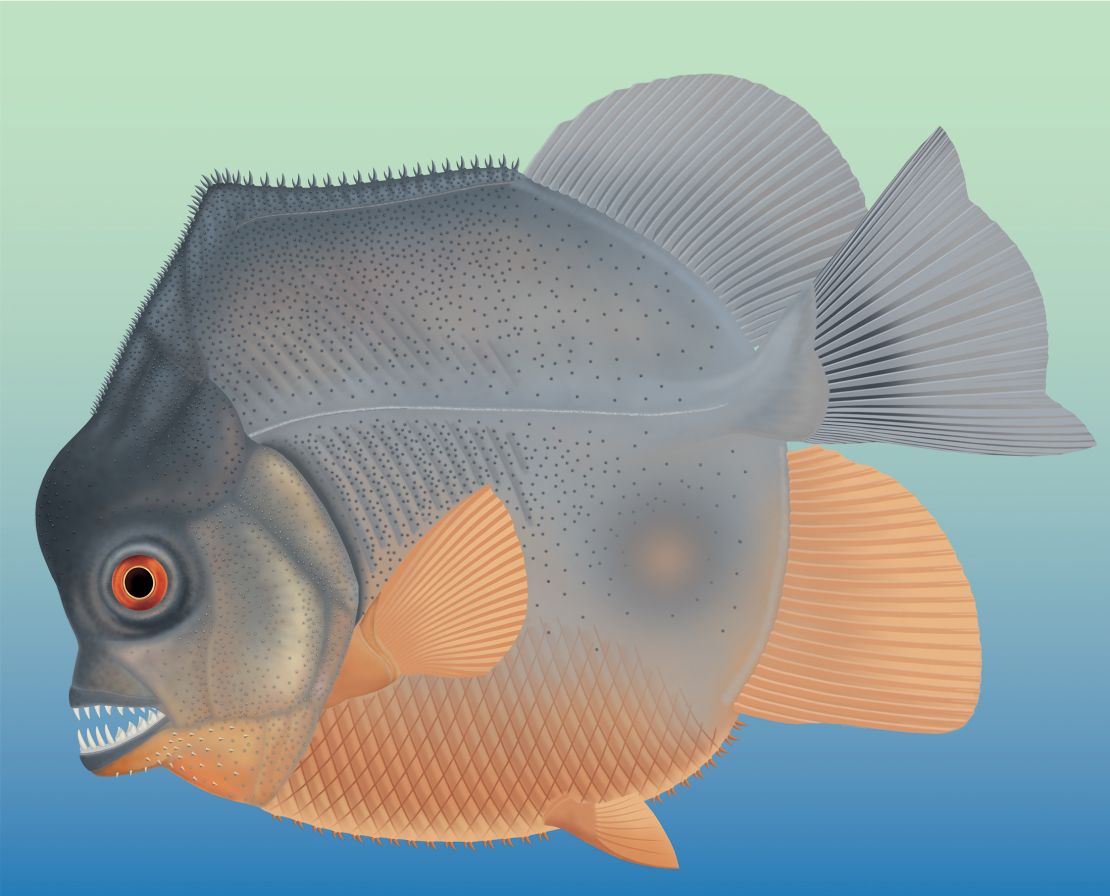Story highlights
A new species of fish from the Jurassic period predates piranhas in their behavior
Its dagger-like teeth could attack and tear flesh from unsuspecting fish
A new fossil discovery looks more like an incredibly well-preserved 150 million-year-old Jurassic crime scene. This species of flesh-eating fish is considered the earliest known to do so. And in the same limestone deposits from South Germany, researchers found its victims, with damaged bodies and fins.
The nearly complete fossil is described in a study published Thursday in the journal Current Biology. It was uncovered in 2016 from the same well-known and -studied fossil deposit that contained the first Archaeopteryx fossil found in 1860.
The researchers have dubbed the fish Piranhamesodon pinnatomus, which combines “piranha” and “fin-cutter.”
Luckily, the jaws were well-preserved and showcased rows of long, pointed teeth at the front of the upper and lower jaws, as well as the exterior of the vormer, the bone forming the roof of the mouth. Researchers also found triangle-shaped teeth with serrated edges along the side of the lower jaw, which would act like scissors.
“We were stunned that this fish had piranha-like teeth,” study author Martina K?lbl-Ebert, director of the Jura-Museum in Eichst?tt, Germany, said in a statement. “It comes from a group of fishes (the pycnodontids) that are famous for their crushing teeth. It is like finding a sheep with a snarl like a wolf.”
Previous examples of pycnodontids used their crushing teeth to eat hard-shelled prey. Their fossils were found with preserved shells and sea urchin spines in their guts.

But these dagger-like teeth, slightly curved backward, were designed to attack. And unlike with other pycnodontids, the researchers realized that their sharpest teeth frequently grew back to replace broken ones.
“Fish as we know them, bony fishes, just did not bite flesh of other fishes at that time,” K?lbl-Ebert said. “Sharks have been able to bite out chunks of flesh but throughout history bony fishes have either fed on invertebrates or largely swallowed their prey whole. Biting chunks of flesh or fins was something that came much later.”
This means that like modern piranhas, which live in fresh water, Piranhamesodon used its teeth to cut flesh. But it now predates piranhas in their behavior.
“The new finding represents the earliest record of a bony fish that bit bits off other fishes, and what’s more it was doing it in the sea,” study co-author David Bellwood, professor in James Cook University’s College of Science and Engineering in Australia, said in a statement. “So when dinosaurs were walking the earth and small dinosaurs were trying to fly with the pterosaurs, fish were swimming around their feet tearing the fins or flesh off each other.”
The jaws of these fish were incredibly strong but short, which meant they could attack with force but not swallow large prey whole. Instead, like modern piranhas, Piranhamesodon would cut chunks of flesh and fin from other fish with no problem.
Due to its flat body shape, Piranhamesodon would have been slow-moving, but it also had large fins that enabled it to maneuver well in the shallow tropical waters where it lived.
This probably means Piranhamesodon would have approached and attacked unsuspecting fish, tearing away scales, fins and flesh, according to the study.
Fish fossils recovered from the same deposit showed evidence of injuries that matches with this style of attack.
“We have other fish from the same locality with chunks missing from their fins,” Bellwood said. “This is an amazing parallel with modern piranhas, which feed predominantly not on flesh but the fins of other fishes. It’s a remarkably smart move as fins regrow, a neat renewable resource. Feed on a fish and it is dead; nibble its fins and you have food for the future.”
































































































































































